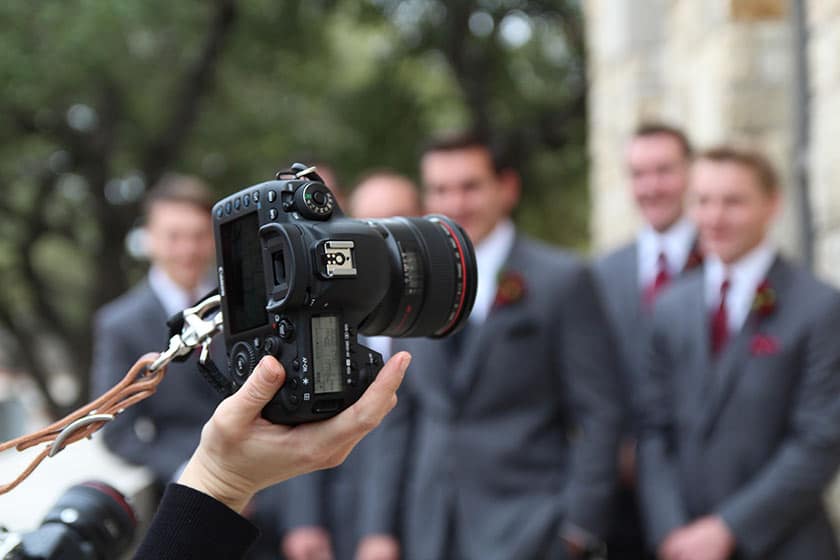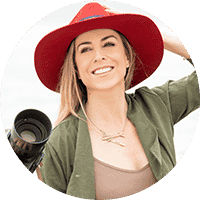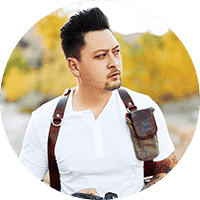The starter gear you need for wedding photography – by 4 experts.
We asked 4 established wedding photographers who have a combined experience of over 50 years shooting weddings: “What is the minimum gear that you would recommend to a new wedding photographer in order to start second shooting or even take on a wedding as the lead photographer for the first time?” This article summarizes the main take-aways from the experience shared by our panelists to help you buy your first gear and build your wedding photography gear bag over time. This article also provides guidance to get started without an initial investment, as well as guidance on how to make your first and subsequent gear investments.
TRUST FACTOR: This article offers advice from established wedding photographers. We have absolutely NO stake in promoting any photography gear brand or product. This article is purely based on advice shared by our expert panel.

Free Download
Download this wedding shoot equipment checklist to make sure you are prepared for every wedding shoot.
STARTER GEAR for wedding photography: the basics
This section covers the minimum photography gear you need to shoot a wedding and why you need this equipment.
PRO TIP: While you can technically shoot a wedding with this gear, our guest experts clearly advise that you need more equipment to do a professional job and minimize risk. Keep reading this article to find out how to get the starter equipment you need at no cost to you.
The basic package
The established wedding photographers on our panel agree that the bare minimum gear you need to shoot your first wedding should include at least 1 camera, 1 flash, as well as either 1 zoom lens or 2 prime lenses.
A camera, maybe a zoom lens or perhaps just two prime lenses – depending on your focus – and a flash. That’s how we all started. That’s really all you need to really shoot it. Now, to shoot the wedding well with experience, variety and exceptional lighting, you need more stuff, but that’s the baseline.
Evan Chung, Evan Chung Photography
Why bring a zoom lens or prime lenses?
This is a must-have because it allows you to capture the moment from an appropriate distance, without intruding on the moment. It’s all about focus. You will either want to be able to be closer or further away from the shot. In order to do that without being intrusive, you will either need a zoom lens that allows you to zoom in and out of the moment. Alternatively, you will need at least 2 prime lenses in order to also capture moments from different depths.
At least, either a good zoom lens or two prime lenses. You have to be able to get sort of close without actually getting right up in people’s grills on their wedding day. So you have to have something that either is a prime telephoto or can zoom.
Amanda Whitegiver, Wild Orchard Studios
TIP: Read this article to find out more about the difference between prime and zoom lenses.
Why bring a flash?
During a wedding, you will shoot at various locations, each with different lighting conditions – and possibly poor lighting conditions. This way, having a flash is a must-have piece of equipment to shoot a wedding.
At most venues, you should definitely have a flash. If you don’t have a flash, either buy one or rent one – or borrow one from a friend for the day and familiarize yourself with it first. It’s inevitable that you’re going to be shooting in a smallish space that has bad lighting at some point. And you’re going to be way happier if you have a flash to fill that in or not use the available (possibly) neon greenish lighting in the space.
Amanda Whitegiver, Wild Orchard Studios
UPGRADED GEAR for wedding photography: a second body
There is consensus among our panelists that you don’t need much to get started. However, you do need more equipment to shoot weddings more professionally and more comfortably – and with less risk. For this, your upgraded gear bag should include an additional camera body.
As professional wedding photographer Amanda Whitegiver advises, a second camera body will serve as a fail safe if one of your cameras malfunctions. Also, this means that you can have a lens on each camera – which makes it easier to shoot throughout the day.
Ideally you want to have a second camera body, because you don’t want to find yourself in a position where your camera has some kind of malfunction and you have no camera. You could have a prime on each camera. Or, you could have a zoom lens on one camera and a prime lens on the other. And that just makes your day so much easier depending on how you like to shoot.
Amanda Whitegiver, Wild Orchard Studios
PRO TIP FOR BEGINNERS: Rent or borrow the equipment you don’t have
If you don’t have all that equipment or you can’t afford it yet, our experts advise that you borrow or rent the equipment that you don’t have. That way, you can shoot like a pro at no extra cost to you.
Indeed, as wedding photographer Amanda Whitegiver mentions, the rental cost is affordable and can be passed on to your client. This will also ensure that you are able to take more professional photos and that you hedge your bets against equipment malfunction.
Starting out, just take what you have and then rent. That’s what I would always do until you get established and you can afford it. Rent some gear, because it’s pretty cheap to rent and you can factor that into what you’re charging.
Amanda Whitegiver, Wild Orchard Studios
FULL GEAR for wedding photography: Bring everything with spares
At the risk of being redundant, while it is technically possible to shoot a wedding with little equipment, there is no room for error at a wedding. So err on the side of caution by bringing as much as equipment as you can – with backups.
Like Jeraime Lu, our panelists agree that you should be prepared for every scenario.
There are so many unpredictable things that happen [at weddings]. [You need an] extra camera body, extra batteries… So much stuff goes into a wedding. If you’re not prepared, we don’t have the option to say ‘I just gotta go home’ or ‘I gotta run to the BestBuy’. We don’t have that option. Renting is amazing. Become friends with local camera shops. Put yourself in a worst case scenario. Just being prepared is the biggest thing.
Jeramie Lu, JeramIe Lu photography
This way, account for every piece of equipment you need and bring two of each when possible. Don’t forget about extra memory cards, flashes, batteries. Again, if you cannot afford it – borrow or rent it. Like destination wedding photographer Laura Grier puts it, this can even include bringing a spare of yourself in the form of a second shooter, who can be your lifeline in case of malfunction.
If you had to pick and choose your must-haves, I would definitely say the 24-70mm and 70-200mm lenses, 2 flashes, extra batteries, and a tripod. Flashes malfunction all the time. And you leave batteries plugged in places and forget them. Also have a second shooter who shoots the same gear as you. It helps because you can borrow stuff from them when something doesn’t work, which I’ve had to do a few times. You definitely have to have a tripod for certain scenarios like doing room shots.
Laura Grier, Beautiful Day Photography
BONUS: Download this wedding shoot equipment checklist to make sure you are prepared for your every wedding shoot.
INITIAL INVESTMENT for wedding photography equipment
As you build experience and bookings, there will come a time when you will want to make your first (or second) investment to acquire your own gear. This initial investment can bear a hefty price tag of over $10,000.
We advised previously that you can borrow or rent the gear that you don’t have for your first shoots. This is a great way to already generate some profits from your first shoots that you can reinvest toward purchasing your own gear in the early stages of your business with little risk.
However, if you do not have cash on hand to make your first investment, there are other options for you to consider. For instance, destination wedding photographer Laura Grier shared her experience buying her initial gear on her credit card for between $10,000 and $15,000, which included lenses, camera bodies and flashes. She reported that with proper care and maintenance, some of that equipment lasted her for decades.
In the beginning, I just put it on a credit card to buy the lenses, the camera bodies and the flashes that you need. And then, I added some fun stuff like an LED panel on a stand or obviously a tripod.
Laura Grier, Beautiful Day Photography
You can honestly get all that stuff for 10 to 15 grand and pay yourself back in just a few weddings. So I think it’s worth buying it. And by the way, I still own some of the lenses I bought when I first started 20 years ago. You take care of them, you calibrate them, you clean them. They’re with you for life, you know?
FUTURE (LONGER-TERM) INVESTMENT for wedding photography gear
As you become more established in wedding photography and build a bigger cash reserve, you may find yourself itching to further invest in your business with gear that can take your art and professionalism to the next level.
Established wedding photographer Laura Grier shared how her subsequent investments went toward two new lenses – the 50mm 1.2L and the 16-35mm lens. She believes lenses are the most important investment you can make, because they are also long-term investments that can span decades.
I started out with the 24-70mm and the 70-200mm lenses. They were the first two lenses I had for a long time. That was before I could afford the 50mm 1.2L. And I really love the 16-35mm lens, because the wide angle gets those dramatic clouds and epic cinematic scenes at a wedding. So those are the two lenses I added later on. Lenses are the most important investment to make. The bodies are changing every couple years, but the lenses will stick with me for a long time.
Laura Grier, Beautiful Day Photography
Watch the full How to get started as a wedding photographer webinar now.






